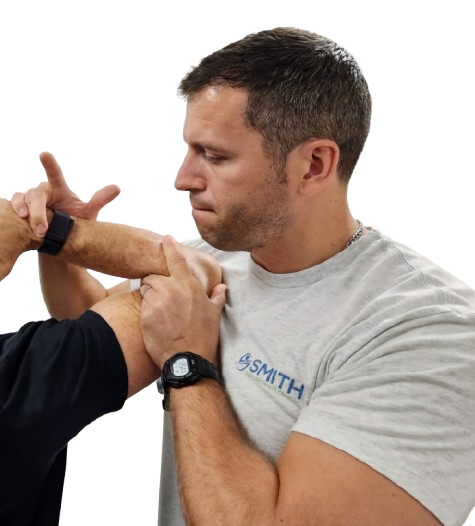Why is everything hurting?
“I feel threatened by my shoulder. How can EVERYTHING hurt?”
This is an actual quote from a patient with chronic shoulder pain.
We see patients who are surprised by how debilitating intense shoulder pain can be. They struggle to reach for objects overhead, behind them, or to the side. They struggle with putting on clothes and getting dressed. They struggle with self-care activities like grooming and bathing. They struggle with seemingly minor household activities: cooking, cleaning, laundry, etc. They struggle to find a position they can even be comfortable in. Their shoulder pain affects how they sleep. They start to complain of shoulder pain causing neck pain, upper back pain, or pain down the arm. They cannot work out due to pain. Sometimes, even something like walking causes shoulder pain. Their activity is drastically constrained.
When symptoms are this intense for a prolonged period of time, it may seem like your world closes into one single point: your painful shoulder.
When we see these presentations, our focus is to find a pattern: what is the primary problem that ties all these symptoms together?
Physical Therapy Solutions for Shoulder Pain
How do the anatomy and function of the rotator cuff impact physical therapy?
What is my rotator cuff injury?
How long till my rotator cuff injury is better?
Why is everything causing my shoulder pain?
Physical Therapy Exercises
Partner and Self Traction
Bracing, Taping, and Training Aids
Shoulder Pain
The shoulder is the most mobile joint in the human body. It is virtually impossible to use your arm without using your shoulder. Even at rest, the muscles around your shoulder still work to support your arm.
The demands placed on your shoulder are extraordinary. The shoulder is controlled primarily by the rotator cuff: a group of 4 small muscles. These small muscles are responsible for controlling the entire weight of your arm. They are active any time you move your arm. The rotator cuff must work efficiently and coordinately countless times in one day.
We often do not appreciate these facts until the shoulder becomes painful.
Basic Shoulder Exam
Every time a patient comes in for an initial session, we take them through the same basic shoulder evaluation. This includes:
- Neck and back screening
- Active motions
- Passive motions
- Strength testing
You may wonder what use this is if every test is painful.
Working through the exam
Even if every test is painful, we can still see patterns emerge which lead to a diagnosis. Part of how we do this is by ranking the tests. There are typically 1-2 tests that are the most painful. These tests in turn have specific structures that they are associated with.
Similar to the most painful test, key signs are extremely valuable in a challenging evaluation. A key sign is a movement or position which recreates a patient’s symptoms. Even if every movement is painful, there are typically specific positions that cause YOUR symptoms. By evaluating this, we can determine which structures are most likely to be involved.
Once we have a list of differential diagnoses from the basic exam and/or key sign, we work through them using treatments we know help for a specific diagnosis. After treatment, we recheck the most painful test or key sign. If there is an improvement, then we know we are on the right track. We will repeat this method until symptoms resolve.
What makes everything painful?
All the information above sounds great, but you may be asking what structures actually make everything hurt. This is not a comprehensive list, but it is four of the most common culprits.
The Shoulder Joint
Any time you move your arm, your shoulder moves slightly. In cases where the joint has become severely irritated, even the smallest movements may cause significant pain. Examples of this include glenohumeral arthritis, frozen shoulder (adhesive capsulitis), or trauma to the shoulder (traumatic synovitis).
The Shoulder Bursa
The bursa is the most highly innervated structure in the shoulder joint. This means it is capable of detecting pain better than any other structure. It is designed to help the joints and tendons glide over each other and move smoothly. This function means it is involved in guiding movement whenever you use your shoulder. In cases where the bursa has become severely inflamed or has been irritated for an extended period of time, it may interpret everything as painful.
Rotator Cuff Muscle
Any time you move your arm, your shoulder moves with it, or a muscle from the shoulder helps create the movement. The rotator cuff is responsible for controlling the shoulder joint and its movement. If a rotator cuff muscle is overworked or injured, it may be painful every time it has to work to control the movement of your arm (constantly).
Instability
Instability causes the shoulder joint to move abnormally. Typically, it will be very difficult to prevent the shoulder from moving too far in a certain direction. In severe cases, your shoulder may sit in an abnormal position, and you may not be able to control the motion of your shoulder when you use it. As this progresses, it can put constant pressure on the joint capsule, ligaments, and muscles. This will lead to pain at rest, and with any movement.
Even in an exam where everything is painful, these four pathologies present differently. They will have different patterns, different subjective descriptions, and different tests which are the most painful.
Conclusion
The biggest takeaway in order to be successful is to rank the tests. If you try to treat every painful test or every problem, you will treat almost every structure around the shoulder.
It can be confusing to work through an evaluation when everything hurts. It can be frustrating and taxing to experience as a patient. However, if a patient and clinician can work through the exam together to identify the most painful test(s), the true problem will emerge.
These presentations are typically one problem which seems like many different things. If you try to treat all the different issues, it will often feel like you go in circles. If you treat the one primary problem, symptoms resolve surprisingly quickly.
In this way, a shoulder evaluation where everything hurts is an exercise in thinking clearly, both for the patient and the clinician.







